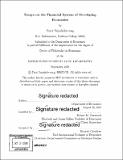Essays on the financial system of developing economies
Author(s)
Sripakdeevong, Parit.
Download1121629764-MIT.pdf (11.93Mb)
Other Contributors
Massachusetts Institute of Technology. Department of Economics.
Advisor
Robert M. Townsend.
Terms of use
Metadata
Show full item recordAbstract
The thesis consists of three chapters, which explore the financial system of rural Thai Villages through the lens of the Townsend Thai Monthly Survey. The first two chapters examine savings behaviour, while the last chapter investigates borrowing. In the first chapter, I apply the estimation technique of Deaton and Paxson (2000) to the monthly version of the Townsend Thai Household Survey and find that individual savings rate decreases with individual age. This result contrasts the flat savings profile found when estimation is conducted at the household level. I further extend the Deaton-Paxson technique to deal with autocorrelation in panel data, and noisy estimates due to small sample size. Applying the appropriate corrections generates the inverse U shape savings rate profile predicted by the life-cycle model. In the second chapter, I test the model of Amador, Werning, and Angeletos (2006) empirically against the data of the Townsend Thai Monthly Survey supplemented by Christopher Woodruff's behavioural survey. From the data, I estimate the model's inputs: the household's income distribution, level of risk aversion, and hyperbolic discount rate. The model identifies the subgroup of households where minimum savings policy is optimal and predicts the optimal minimum savings value. For this subgroup, I find that the predicted minimum saving values have a strong positive correlation with the actual amount saved by the household. The relationship is weaker for households outside the subgroup, as the minimum saving policy is no longer optimal. The third chapter, joint with Robert Townsend, documents the existence of active, high volume and relatively sophisticated money markets in villages in Thailand. As with traditional markets, loan repayment can be deferred through standard restructuring. But there are also more complicated credit refinancing chains involving multiple parties and short/medium maturities. From risk sharing regressions, we find that borrowers surprisingly have higher income coefficient than non-borrowers. However, this is not because financial access is detrimental, but instead due to the self-selection into debt of more risk-tolerant individuals. Yet, those engaged in credit refinancing chains have the smoothest consumption against income shocks of all, as risk tolerance is dominated by low transaction and verification costs.
Description
Thesis: Ph. D., Massachusetts Institute of Technology, Department of Economics, 2018 Cataloged from PDF version of thesis. Includes bibliographical references (pages 94-97).
Date issued
2018Department
Massachusetts Institute of Technology. Department of EconomicsPublisher
Massachusetts Institute of Technology
Keywords
Economics.